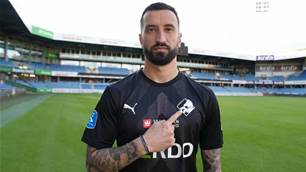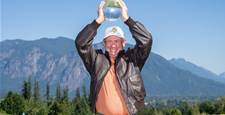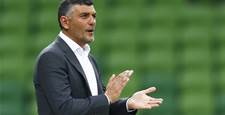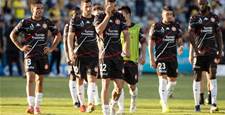EXCLUSIVE: More and more Socceroos are forging club careers in the Asian Football Confederation – and it’s a trend the players say is set to remain as the region's financial muscle grows.
January’s transfer window underlined an evolving trend across Australia's football landscape.
Three talented Australians – all with Socceroo experience on their resumes – inked major deals with big clubs in the Asian Football Confederation.
Exciting striker Nathan Burns, who debuted for the green and gold in 2007, turned his gaze away from Europe after four years with AEK Athens to sign with the Korea Republic’s K-League outfit Incheon United.
Joining him in this regional power-base was former Italian-based defender Adrian Madaschi. He wrapped up a successful short-term deal with Melbourne Heart to link up with Jeju United making his K-League debut last weekend in their 3-1 win over Burns’ boys.
The Korean exodus was given extra impetus when forward Matt Simon - after 36 goals over six years at Central Coast - departed to join Chunnam Dragons.
Not to be outdone, China is also capable of attracting our best.
February’s transfers of former Socceroo Mile Sterjovski from Perth Glory to Chinese Super League side Dalian Aerbin, and highly rated Mariner Rostyn Griffiths, who inked a lucrative deal with Guangzhou R&F, showed that league’s ambition is matched by financial power in this booming economy.
Home fans may despair but it’s the nature of a global business like football.
In the space of a month five talented Australians joined an existing and expanding base of players across the AFC in some of the region’s biggest leagues.
It’s why many are calling this era the rise of the ‘Asia-Roos’.
The Korean Republic has become a hub of Oz activity in recent seasons. Talented ex-Roar defender Luke DeVere signed for Gyeongnam FC last season, joining goal-scoring stopper Robbie Cornthwaite at Chunnam Dragons who also inked a deal a year ago.
And this year, defender Eddie Bosnar swapped Japan’s Shimizu for South Korea linking up with Suwon Bluewings.
For Simon, when the opportunity came for him to join the K-League and play aIongside fellow countryman, it was a no-brainer.
“The facilities here at Chunnam are excellent and there are some unbelievable players in the squad,” he told au.fourfourtwo.com.
“I moved to Korea because the opportunity was too good to pass up. The training and the games are so fast over here and I believe my game will get better as a result.
“And with so much training and so many games I will be fitter than ever.
“I would definitely recommend the K-League to Australian players. It’s a good league and the clubs’ facilities are excellent. You really feel like a professional footballer over here.”
While a new generation of our footballers strive to make their mark in Korea, there’s one Aussie who’s already secured superstar status there: Sasa Ognenovski.
The Socceroo, who lined up against the Saudis last month, impressed so much during Adelaide United’s AFC Champions League run in 2008 that K-League heavyweights Seongnam Ilhwa Chunma signed the defender.
His subsequent success blazed a trail for the green and gold rush north and, other than Josh Kennedy in Japan; the big man's success has had the most impact in kick-starting the Asia-Roos trend.
The big man’s accomplishments included the honour of becoming club captain and being voted the prestigious AFC Player of the Year in 2010.
Throw in a goal, a winner’s medal and a Man of the Match award in the AFC Champions League Final of the same year - as well as gaining his first Socceroo caps - and you could easily argue Ognenovski has been Australia’s most successful Asian export.
Ognenovski’s Korean link was forged years earlier when he was playing for Queensland Roar.
Korean player Shin Tae-Yong enjoyed a stint with the Roar and later coached Ognenosvki’s club in the K-League.
“He knew me as a player and as a person,” Ognenovski told Australian FourFourTwo magazine.
“So that made the decision easier. It was important for me to find a coach that knew me and respected me, instead of a new manager who gives you only three or four games to impress.
“Also the club is based out of Seoul which is a great place to live and to train; the facilities are great. It’s a great place for my family. Seoul as a city is buzzing.
“And the Koreans think I look like Hugh Jackman!”
Look beyond Korea and the Asia-Roos trend is just as strong in neighbouring Japan.
Striker Josh Kennedy stands tall in every sense and is probably the most well-known Australian player in J1.
The Victorian’s goals at Nagoya Grampus have shone a light on the green and gold’s reputation and, like Ognenovski in the Korea Republic, he has become the ‘face’ of Australian players in Japan.
And as we saw this week with FC Tokyo, the J-League is still a class above.
Fellow striker Alex Brosque is another Aussie finding his feet and the net in Japan with Shimizu S-Pulse.
In fact, the ‘J-Roos’ Brosque and Kennedy accounted for five of the Socceroos’ first eight goals scored in Australia’s 2014 FIFA World Cup Asian qualifiers.
Brosque topped and tailed the group with an impressive brace against the Saudis last week to underline the success of his move from Sydney FC over a year ago.
But it’s not just goal-scorers making a mark; our defenders have been making a name for themselves in the Land of the Rising Sun.
Continued on next page...
Geelong-born Matt Spiranovic has carved out a career with the Saitama-based Urawa Red Diamonds since joining in 2010 from the German Bundesliga.
Mark Milligan at JEF United (currently on loan to Melbourne Victory) and Consadole Sapporo’s Jade North have also made important contributions at their respective J1 and J2 clubs.
In fact, in North’s case, he became the first Indigenous Australian player to have plied his trade in Japan.
Elsewhere and, as we’ve seen with Sterjovski and Rostyn Griffiths, the booming Chinese Super League has both ambition and money.
One player who has seen the league grow is former Newcastle Jet Joel Griffiths, who recently moved from Beijing Guoan to link with Shanghai Shenhua (where he partners Nicolas Anelka, no less, in attack).
Meanwhile Socceroo skipper Lucas Neill at Al Jazira and Al Nasr’s Mark Bresciano are playing for clubs currently vying for the title in the UAE Pro League and are enjoying a new lease of life in that part of the region.
Interestingly also is a trend for our coaches to move into the region. While not at the same rate as our players, it’s satisfying to see former A-League coaches such as Lawrie McKinna at China’s Chongqing Lifan.
Elsewhere ex Adelaide United assistant Phil Stubbins now coaches in Thailand while Steve Darby, Gary Phillips and Scott O’Donell have blazed a trail across Asia for many years.
The move of FFA into Asia in 2006 has brought us closer to the region with Australia now tapping into a vast, fast-improving and ambitious part of the global football fabric.
For the national team, Asia-Roos playing in FIFA World Cup Asian qualifiers cuts down on long-distance travel for vital matches, while also making scouting of potential opponents far easier.
At club level, it has also enabled our players to show their wares in the region at such showpiece events as the AFC Champions League, giving them a taste of the big time in Tokyo, Beijing and Seoul.
The best example was Adelaide United’s stunning run to the AFC Champions League Final in 2008. Current Australian U-23s coach Aurelio Vidmar’s Reds caught the imagination of the sporting public across China, Uzbekistan and Japan, as well as back home in Australia.
Australia’s Asian move has also allowed our players to access the AFC 3+1 visa rule, which allows for greater scope for AFC players to move within the region, noted Matt Simon, who made his debut for the Dragons who played out a 0-0 draw at home to Gangwon in last weekend’s opening round of K-League action.
“I think it’s a great rule and it gives a better chance for more Australian players to gain moves into one of the AFC leagues.
“I think it will continue because Australians have come here and have done well and they really like the Australian mentality.”
Former A-League star Cornthwaite has reinvented himself at Chunnam.
He played a full 90 minutes last weekend for his club, which bodes well for the long season ahead.
The 26-year-old, now beginning his second season at the club, was regularly voted by local journalists as one of the best imports last season.
Wisely, he was given a chance to slowly acclimatise to the Korean game’s style, pace and nuances.
“The attraction for me to the K-League was to test myself in a very competitive league,” Cornthwaite said. “Without doubt I’m playing the best football of my career.
“Just coming over here has really freshened up things for me. In fact it could’ve been ideal to make a move here earlier [in my career].
“I was looking for a new challenge out of my comfort zone,” added Cornthwaite, who is coached by Jung Hae Seong, a devotee of the Barcelona method of training.
“The facilities are first class with all Korean players eating, living and training together day in day out. But the obvious factor is they have a much larger budget. I think in general, Asia is great for Aussie players to get paid good money and still have a chance of making the Socceroos.
“Playing every week against Asian opposition is only good come World Cup and Asian Cup qualification. And with the AFC 3+1 rule, it has opened a window that may not have made these leagues accessible to Aussie players before.”
The Korea Republic is starting to produce some fabulous young footballers, such as Korean U-20 World Cup player Lee Jong-Ho, who is said to have been approached by Inter Milan when he was 17.
Sunderland fans are raving about their young striker Ji Dong-Won. The 20-year-old scored the winner for Sunderland in last month’s memorable 1-0 win over Manchester City.
Jong-Ho and Dong-Won have emerged off the back of serious money being invested in clubs, coaching, and facilities and youth programs.
In terms of football culture, it's a good place to be.
Cornthwaite, capped for Australia in 2009, says the Korean football schedule is very much a European one, which he believes can help Australian players.
“The only way to improve is to train and play," he said. "This season in the K-League there are 44 league games, so along with a very difficult pre-season, it is only going to be a benefit to be playing that much.
“This Asia-Roos trend will continue as long as Aussie players continue to do well and show we are a strong football nation.”
Cornthwaite believes it takes a certain type of person to make the move a success.
“You don’t have a lot of free time; it’s all about football but for anyone up for a challenge it’s a great place to play football.”
Little wonder our players are happy, playing for clubs with world-class facilities and under coaches with vast experience.
“I’m under a great coach in Huh Jung-Moo who took the Korean national team to the World Cup and is highly respected here,” added Nathan Burns.
Likewise Jade North, now with J1 side Consadole Sapporo.
He spent last season with FC Tokyo in J2 as they won the league. “It was an enjoyable season,” said the versatile former Newcastle Jets, Incheon United and Perth Glory player who was in the Socceroo starting XI against the Saudis last week.
“I didn’t play that much but we absolutely dominated the league. And you enjoy going to training because of the set up and the facilities. Now that I’ve seen how professional things are here in Japan, it’s unbelievable.”
North also proudly flies the flag for Indigenous Australia.
Football is a global game. The A-League is a cosmopolitan mix and similarly Australians are popping up across the region. India’s Premier League, Indonesia, Thailand and Vietnam are just some of the exotic locations to also feature clubs with Australian footballers.
Likewise, it’s a fascinating mix when the Socceroos fly in from all points of the globe: A-League players rub shoulders with a growing number of AFC players and European-based stars, comparing frequent flier miles and sharing jet-lag tips.
And that has to be a good thing.
Our players are now influenced by different tactical styles and conditions - and with the rise of the Asia-Roos showing no sign of abating - it surely makes for a more adaptable and experienced squad on the road to Brazil 2014.
This feature first appeared in The Socceroo magazine -
Copies of The Socceroo magazine are available for purchase online here
Follow me on Twitter @Aidothejourno
Related Articles

Socceroos midfielder embraces move to England
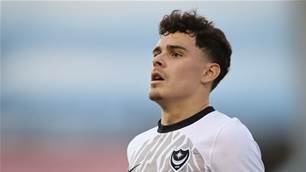
Cardiff City snap up sought-after Socceroos starlet
